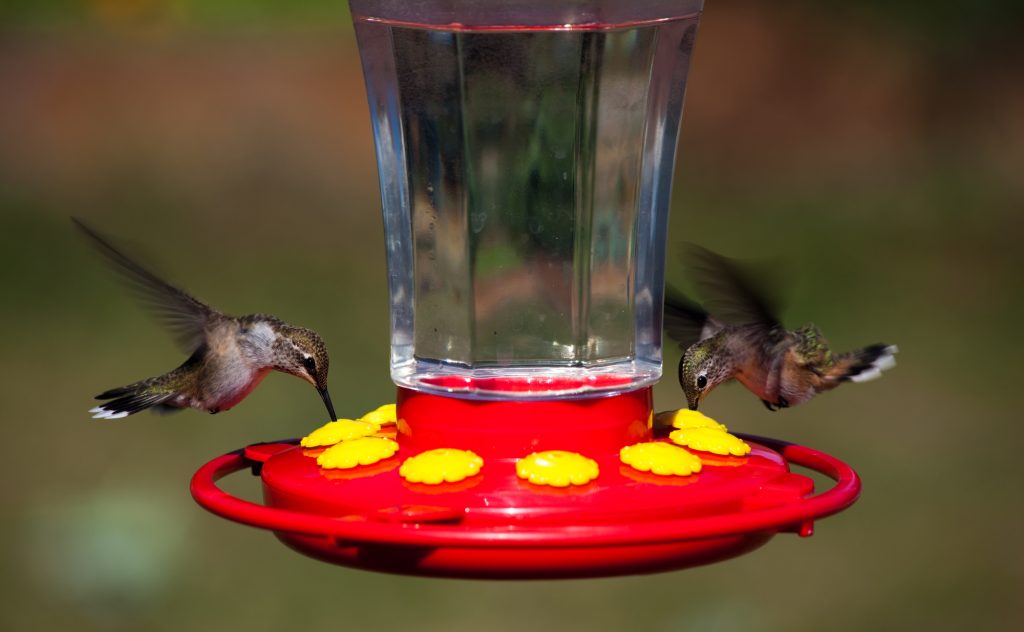The seed that attracts the widest variety of birds, and so the mainstay for most backyard bird feeders, is sunflower. Other varieties of seed can help attract different types of birds to round out your backyard visitors. In general, mixtures that contain red millet, oats and other “fillers” are not attractive to most birds and can lead to a lot of waste as the birds sort through the mix. Also, corn may be included in this list for it attracts unwanted birds like starlings and grackles.
By far the seed that attracts the most birds is sunflower seed. There are two kinds of sunflower — black oil and striped. The black sunflower seeds (“oilers”) have very thin shells, easy for virtually all seed-eating birds to crack open, and the kernels within have a high-fat content, extremely valuable for most winter birds. Striped sunflower seeds have a thicker shell, much harder for House Sparrows and blackbirds to crack open. So, if you’re inundated with species you’d rather not subsidize eating your black oil sunflower, before you do anything else, try switching to striped sunflower.
Safflower has a thick shell, hard for some birds to crack open but is a favorite among cardinals. Some grosbeaks, chickadees, doves and native sparrows also eat it. According to some sources, House Sparrows, European Starlings and squirrels don’t like safflower but in some areas seem to have developed a taste for it.
Cardinals and grosbeaks tend to prefer tray and hopper feeders, which makes these feeders a good choice for offering safflower.
No shells. No mess. 100 percent edible.
The No-Mess Blend is great near flower beds, patios and decks.
The No-Mess Blend bird seed features seeds that have had their shells removed so only the meat of the seed is left. No hulls on the seeds make for tidier feeding since there’s no debris on the ground to clean up. Pound for pound, No-Mess Blend bird seed offers the best value because you do not pay for uneaten seed waste. The birds eat everything.
The No-Mess Blend’s mix of sunflower chips hulled white millet and shelled peanuts appeals to birds that eat at the feeder or on the ground.
Jewels of the Garden, the Hummingbird
During the summer months, everyone enjoys the sighting of hummingbirds. In the Jefferson County area, it is best to set the hummingbird feeder out during Derby Week. It’s best to use a non-gravity feeder that looks like a flying saucer because bees, yellowjackets and wasps find it difficult to get to the nectar because the liquid does not come within the feeding port.
For centuries, gardeners have been fascinated with the beauty and aerobatics of hummingbirds. The key to attracting hummingbirds to your yard is to plant lots of flowers and provide the habitat that will give them shade, shelter, food and security.
Plants, including flowering shrubs, dwarf trees and vines, can all be used to create an ideal tiered habitat from ground level to 10 feet or more. Provide lots of space between plants to give hummingbirds enough room to hover and navigate from flower to flower.
Hummingbirds love water, especially if it’s moving. A gentle, continuous spray from a nozzle or a sprinkler hose is perfect for a bath on the fly.
Hummingbirds do not have a keen sense of smell and rely on bright colors to find their food.
They are particularly fond of red and are often observed investigating feeders with red parts, red plant labels, red thermometers and even red clothes on a gardener, I even had one hover around my red gas container. Note: Do not use red dye in a hummingbird feeder, there is concern that it may harm the birds. Instead, use plain, clear sugar water (one part white sugar mixed with four parts water). The hummers love it! If your feeder does not have red on it, attach a red label or other item to attract them.
Brightly-colored flowers that are tubular hold the most nectar and are particularly attractive to hummingbirds. These include perennials such as bee balms, columbines, daylilies, and lupines. Biennials such as foxgloves and hollyhocks and many annuals, including cleomes, impatiens and petunias.
And lastly, hummingbirds do consume small beetles, true bugs, weevils, flies, gnats, mosquitoes, aphids, mites, leafhoppers, flying ants and parasitic wasps. Their favorite insect food source is the spider and harvestmen (daddy long legs).








Comments 1